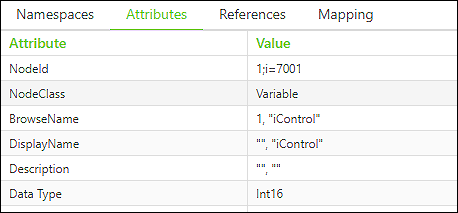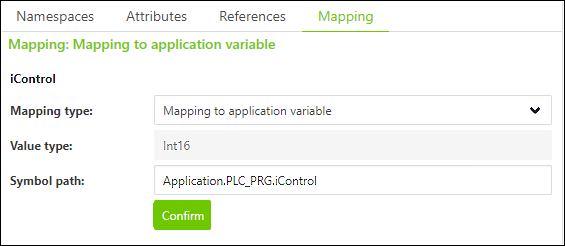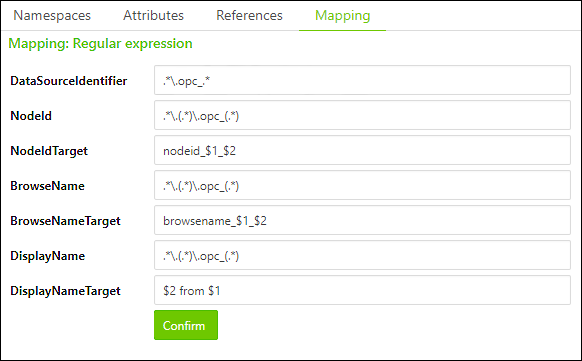Information Model and Mapping Properties
Depending on the element selected in the “Information Model” area, additional information is displayed in this area based on the context.
“Namespaces” Tab
This tab shows the namespace on which the information model is based.

“Attributes” Tab
This tab shows attributes and values of the selected element.

“References” Tab
This tab shows the reference types used with node class, name, modelling rule and data type for the selected element (see also Add References).
If the reference can be deleted (this applies, for example, to references that you have created yourself), a trash can icon  is displayed to delete the entry (see Delete References).
is displayed to delete the entry (see Delete References).

“Mapping” Tab
This tab is only displayed if an element of the information model is selected for which mapping with application variables is possible.
When selecting a variable, the “Mapping” tab shows the following settings:

Mapping Type | Description |
|---|---|
No mapping | “No Mapping” is displayed if the variable selected in the information model is not (yet) mapped to an application variable. |
Mapping to application variables | “Mapping to application variables” is displayed if the variable selected in the information model is mapped to an application variable (see Map Application Variables to Information Module Variables/Objects). In this case, the data type and symbol path of the linked application variable are displayed. |
Mapping to a static value | A static value is assigned to the variable (see Assign Static Values to Variables). |
When selecting an object, the “Mapping” tab shows the following settings:

Parameters | Description |
|---|---|
DataSourceIdentifier | The symbol paths of all available application variables are filtered using this regular expression. |
NodeId/ | For each symbol path already filtered using the “DataSourceIdentifier”, a NodeId string is generated using the “NodeId” and “NodeIdTarget” properties. The “NodeId” property specifies a regular expression that is applied to the symbol paths that have already been filtered. The “NodeIdTarget” property compiles the final NodeId value of the OPC UA variable from the components of the regular expression of the “NodeId”. |
BrowseName/ | Similar to the “NodeId” property, the OPC UA BrowseName is generated from the already filtered symbol path using these properties. |
DisplayName/ | Similar to the “NodeId” property, the OPC UA DisplayName is generated from the already filtered symbol path using these properties. |
The description for using regular expressions is available at Use Regular Expressions to Filter Application Variables.